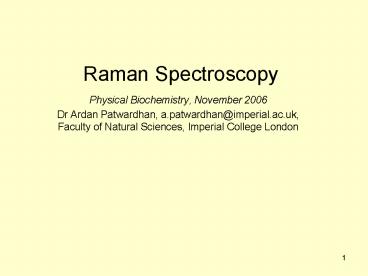Raman Spectroscopy - PowerPoint PPT Presentation
1 / 10
Title:
Raman Spectroscopy
Description:
Aqueous solutions can be used. Any wavelength can be used ... Aqueous solutions can be studied. Can provide information complementary to IR spectroscopy ... – PowerPoint PPT presentation
Number of Views:972
Avg rating:1.0/5.0
Title: Raman Spectroscopy
1
Raman Spectroscopy
- Physical Biochemistry, November 2006
- Dr Ardan Patwardhan, a.patwardhan_at_imperial.ac.uk,
Faculty of Natural Sciences, Imperial College
London
2
Polarizability in an electric field
- An electric field will distort the molecular
orbital - This is a weak effect that grows with the square
of the intensity
3
Induced electric dipole moment
- An electric field can distort the electron cloud
of a molecule, thereby creating an induced
electric dipole moment - The oscillating electric field associated with EM
radiation will therefore create an oscillating
induced electric dipole moment which in turn will
emit, i.e. scatter, EM radiation
4
Raman scattering
Molecule
Scattered photon hnsc
Excitation photon hnex
- Rayleigh scattering elastic interaction, no
non-kinetic transfer of energy between molecule
and photon, nsc ? nex - Raman scattering inelastic interaction, transfer
of energy between molecule and photon, nsc ? nex - Stokes lines Energy of molecule increases, nsc lt
nex - Anti-stokes lines Energy of photon increases,
nsc gt nex
5
Energy level diagram
- Virtual energy levels do not correspond to an
actual absorption
6
Raman spectra
- Transitions between vibrational/rotational levels
will lead to spectral lines on either side of the
excitation line - The spectra on the stokes side will be more
intense than the spectra on the anti-stokes side
due to a significant difference in population
between vibrational levels - The difference in energy between these lines and
the central excitation line corresponds to
energies for pure transitions
Stokes
Anti-stokes
7
Raman versus IR
- Aqueous solutions can be used
- Any wavelength can be used
- Variation in polarization is a requirement rather
than variation in dipole moment ? some normal
modes that do not show up in IR spectra may show
up in Raman - Good examples are homonuclear diatomic molecules,
e.g. oxygen !! - Some normal modes are invisible to both IR and
Raman spectroscopy!!!
8
A comparison of spectra
9
A Raman Spectrometer
- The required high intensities require laser
illumination that is focused onto the specimen - Light from the illuminated spot is collected
using a lens and scanned using a monochromator
10
Main Points
- A vibration must involve a variation in the
polarization of the molecule for it to be visible
in Raman spectroscopy - The vibrational spectra is centred at the
wavelength of the source - Aqueous solutions can be studied
- Can provide information complementary to IR
spectroscopy































